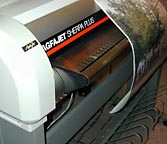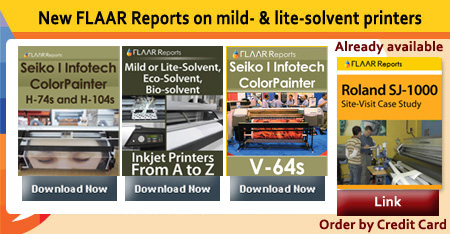Mutoh wide format printer comparison.
What about Mutoh wide format printers? How do they compare with Encad NovaJet or Hewlett-Packard DesignJet 2800CP, 3800CP, 5000 or newer models?
Mutoh is a known and respected company. Actually it's a Mutoh factory which manufactures Epson wide format printers. And its Epson printheads which are inside most Mutoh printers (Mutoh solvent ink printers may use Xaar or Spectra printheads).
Problem is, Mutoh wide format printers are hard to find in action, probably because Encad, ColorSpan, and Hewlett-Packard are so popular, with the Epson growing rapidly in market share as well.
It took considerable effort to pry sparse tidbits of information from the terse corporate web site, namely that Mutoh printers are basically OEMed as various other brands. For example, the original Falcon is a 180 dpi printer rated at 720 dpi. All the Epson, Roland, and Mimaki printers of this piezo generation were 180 dpi; the newer generation printheads are rated at 360 dpi. Why the discrepancy with 720, 1440, 0r 2880? Those larger numbers are based on software, on additional passes to lay down more rows of 360 dpi dots until the total of going back and forth over the page equals 720, 1440, or 2880. The result we have seen from Mutoh printers at their top resolution is very handsome. Downside is their slowness to achieve this quality. However some print shops are willing to accept the delay if they need to produce just one or two prints. If you need to reproduce 20, or 200 prints, you need a machine with a thermal printhead: piezo is still to slow for commercial production in most cases.
Previously Mutoh did not sell direct. In America the easiest way to buy a Mutoh was to order one of the several sizes of Agfa Sherpa. Another variant of the Mutoh showed up as the Phaser 600, a rather unique solid-ink system for Tektronix.
Solid ink in general (usually nicknamed "melted crayons") does not impress people in the fine art world. Photographers and people with a graphic-eye want better quality. MacUser magazine noted "noticeable banding." You can reach your own conclusion on whether you would buy this kind of unusual technology. After all, if melting solid wax was so super, why don't other companies use it? Why is no one, no one else even experimenting with melted crayons...
In other products Tektronix, now Xerox-Tektronix, produces the best color laser printers around. Just watch out for their melted wax desktop printer; it's good for printing on transparencies for overhead projectors, but it is not good for graphics quality and not good if you need continuous tone photographs or exhibit quality work. The Tektronix model that uses laser toner, their Phaser 780 I believe, is outstanding. See www.laser-printer-reviews.org. Anyway, the Mutoh solid-ink printer is no longer manufactured that I know of, but since used examples still linger on e-Bay, it's good to know what to expect from such obsolete technology.
Gerber markets an OEM Mutoh also as a vinyl cutter. We got the impression that one of the Iris (CreoScitex) printers is also actually manufactured by Mutoh; indeed if you peel off the Iris label on the ink cartridge, it says Epson underneath. So would Mutoh inks. The ink for Mutoh, Roland and Mimaki comes from Epson. They get it from some ink company, reportedly Toyo but no one says for sure one way or another
 Another
OEM is the PrismJet HiFi, from SignWarehouse in the USA.
Same situation, Epson heads, Mutoh body, SignWarehouse
label. However thermal printers such as Encad, ColorSpan,
and HP are faster and more versatile for printing signs.
Another
OEM is the PrismJet HiFi, from SignWarehouse in the USA.
Same situation, Epson heads, Mutoh body, SignWarehouse
label. However thermal printers such as Encad, ColorSpan,
and HP are faster and more versatile for printing signs.
Rebranded Encad printers are easier to spot: Ilford, Kodak USA, and Oce, among others, repackage Encad printers. Graphtec used to but recently switched to Hewlett-Packard.
I see Mutoh wide format printers at various trade shows. But until we have a Mutoh available to test in person in our own facility, I prefer to discuss the printers that I know from firsthand experience in the FLAAR studios, namely Encad, ColorSpan, Mimaki, and Hewlett-Packard. For example, how many of the inherent Epson problems are inherited by the Mutoh printers? Problems such as fast-fade disappearing dye inks, glacially slow at high resolution, etc. Again, it may very well be that the Mutoh has solved these problems such as banding, which is a real bugaboo for Roland still today. The Agfa GrandSherpa we recently inspected was producing nice output, even acceptable backlit. The print shop owner said he was content.
For any 1440 or 720 dpi printer, be absolutely sure that you realize these printers are incapable of printing photo-realistic quality at production speeds of 180 to 360 dpi. If you set these printers to FAST speed the quality collapses to 360 dpi, which may look worse than draft quality. In other words, you cannot sell a print resulting from production speed. So if you are a sign company, you might want to consider a faster printer to create your signs quicker and hence earn more profit. The ColorSpan, Encad and the Hewlett-Packard both do signs perfectly. Canon is out of consideration since it can't accept any pigmented inks yet.
Most recently updated August 22, 2002.
Previous updates: August 02, 2001.
 |